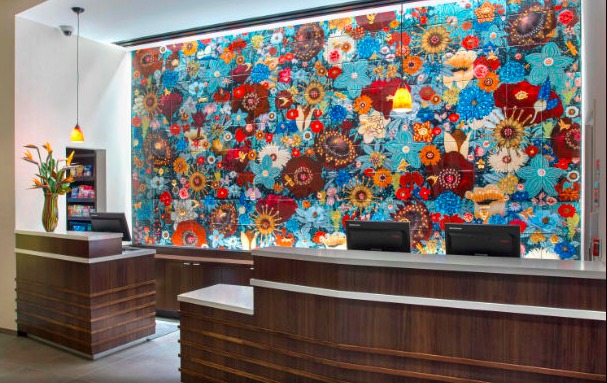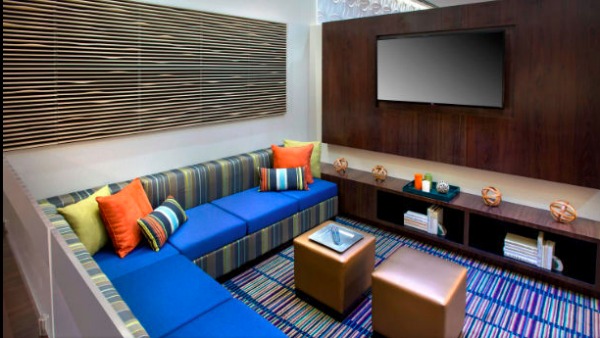Meet Courtyard Marriott Chelsea — How Select Service Hotel Brands Won Over Manhattan
Earlier this month I attended the opening party for the new Courtyard Marriott Manhattan/Chelsea, a 273-room “sliver” hotel built from the ground up in New York’s once-flourishing Fur District. (If you visit, check out the clever stone reliefs of fox heads on a nearby building.)

A bespoke backdrop behind the check-in desk at Courtyard Marriott Chelsea
As servers passed around wine, savories and mini s’mores, well-dressed guests mingled in the hotel’s lively interpretation of Courtyard’s new multi-tasking lounge with its communal table, breakfast area, private booths with flatpanel TVs and, for the requisite splash of local color, photographs of Big Apple landmarks snapped by New York artists.
Once the ribbon was cut, Tim Ariowitsch of Altitude Capital Management, the hotel’s owner, explained how the newest Courtyard came to be. This very spot once housed the Ariowitsch family business, a fur garment factory. As fur’s popularity plummeted, the family found itself with an empty building on a prime piece of real estate not far from the Macy’s, Madison Square Garden and Garment District factotums like the Fashion Institute of Technology. What to do?
Knock down the factory and build something new. But what? After much study, the obvious choice was a hotel, Ariowitsch said. And even though the family had no experience in the hospitality business, Marriott does, hence the decision to go with a franchise, specifically a select service brand.

The colorful lobby theater area at Courtyard Marriott Chelsea
We’ve seen branded select service hotels pop up all over Manhattan. Many are built from the ground up on slender parcels in the western reaches of Times Square and Chelsea, once a thicket of low-slung warehouses and factories. Within the immediate orbit of the new Courtyard there’s a Hilton Garden Inn, Hyatt Place, Holiday Inn Express, Fairfield Inn, Wingate by Wyndham Manhattan and Indigo Chelsea, newish slivers all.
Select service brands inhabit old buildings as well, like the Courtyard Marriott Manhattan/Herald Square that opened last year in a graceful structure built in 1928 to house a bank.
All told, it’s a lot of new franchise hotels for one island, even if the island is Manhattan. Courtyard Marriott alone boasts nine Manhattan outposts including the 378-room Courtyard Marriott Manhattan/Central Park, the bottom half of the tallest hotel in North America.
Why so many? And is it too many?
Not yet, says John T. Bowen, dean of the Conrad N. Hilton School of Hotel and Restaurant Management at the University of Houston, who calls New York “a very good market for the hotel industry.”
There’s no mystery why the ranks of select service hotels built from the ground up has grown. Without restaurants and large meeting spaces, select service hotels don’t deal with food and beverage services, which can be money losers, particularly in urban locales with high labor costs.
And the relatively small plots of land they occupy are ideal for hotels whose primary business is rooms. “Without the multiple restaurants, lounges and meeting spaces of a full-scale Hilton, Marriott or Sheraton, a select service hotel can go into a much smaller space,” Bowen said in a phone chat.
As for a deep knowledge of hotels, it’s more important that the owners are knowledgeable about business, he adds. “They don’t really have to understand too much about the hotel industry if they select a good brand and a good management company.”
Choosing a brand is also pretty straightforward. Owners meet with the major companies to learn what they offer and tend to go with the brand whose culture fits the hotel they have in mind. All brands are up for grabs, in other words, unless they already have a property in the neighborhood.
As for those multiplying Courtyards, brands usually have a formula for determining how many is too many, Bowen says. Factors include occupancy rates at the brand’s nearby hotels, whether those hotels are doing well and whether another outpost can be supported without cannibalizing business at existing properties.
Indeed, New York’s vast network of neighborhoods is one reason Courtyard Marriotts – and Hilton Garden Inns and Alofts and Indigos – are proliferating. Visitors coming to New York to see Broadway plays usually don’t want to stay in the Financial District or Brooklyn.
And if they’re locked into a loyalty program, the familiar brand often wins out over an independent hotel.
The upshot? Expect more in Manhattan, at least for now.

Thanks for explaining this slice of our urban landscape and the business reasons behind what we’re seeing. Makes sense, I guess.
Thanks, Andrew. I think it does make sense — as long as room demand continues.
Interesting, and smart to attract the hospitality industry here, where people need it most?!
I agree. Thanks, Wandering Eds.
Always so interesting to get the insider scoop from you on what’s going on behind the scenes in the NY hotel world…
Thanks, Lillie.
I’m fascinated by all of your insider knowledge! I think I was too busy trying to avoid getting run over while in NYC to notice all of the hotels!
Smart move, Cat! Thanks.
Very interesting! I hate to see the independent hotels lose out, but it’s also nice to have a familiar hotel to stay at in a new city, so I can definitely see the appeal.
I agree, but I don’t think independents are losing out. For every guest who’s soothed by the familiar at a chain — and wooed by their value points — there’s another who wants a hotel that’s like no other. And New York can accommodate both. Thanks, Micki.
I like Marriott – you know what you’re getting… regardless of where you are in the world.
Elle x
So true, Elle. Thanks.
Another great insider guide to the world of NYC hotels.
Thanks, Matthew.
Thanks for the interesting insight into how hotel brands are chosen in NYC. I’m glad that there is enough demand to support both independent hotels as well as national chains.
Me, too. Thanks, Mary.
Being relaxed, lots of foreplay and talking withオナドール your partner will all help to make an orgasm more likely.